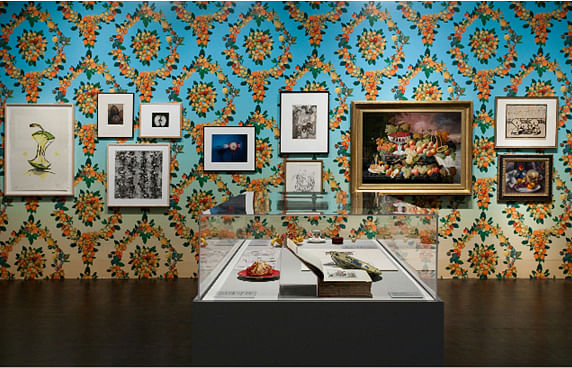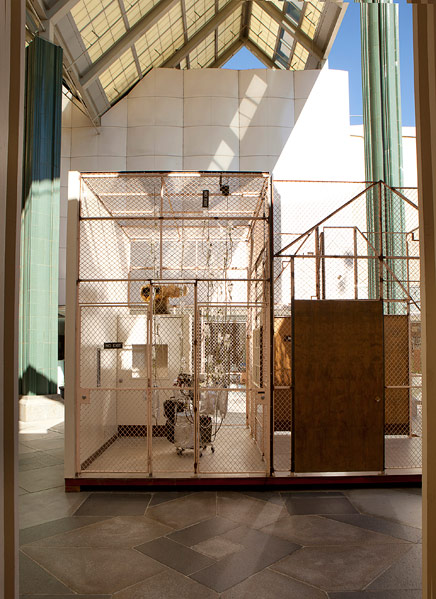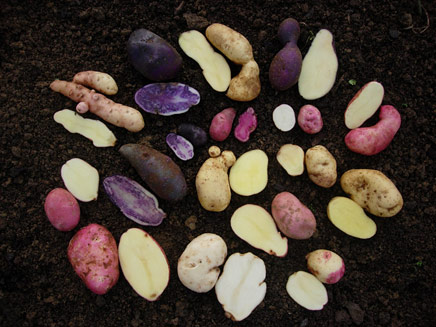

by Bruna Mori
On November 7, dozens of artists, writers, and collectives ceremoniously participated in Let Them Eat LACMA , closing Fallen Fruit’s EATLACMA , a yearlong investigation of food, the natural growth cycle, and the social role of art. That day, over 7,000 visitors to the Los Angeles County Museum of Art made their way to scheduled events, intersecting with chewing carolers, belly-listeners, and roving bands that unified the fragmented campus; weaving through fruit-droppers, vocal mimes, and hungry puppets, I had my second look at Fallen Fruit’s recuration of the permanent collection and garden structures.
In Fallen Fruit Presents The Fruit of LACMA , David Burns, Matias Viegener, and Austin Young set artwork against a rich wallpaper vine without a spot of white. Bountiful crops in still-life repose or about to be devoured provided an analysis of fruit, trends, and technologies over a span of hundreds of years. Looking more closely, there was withering fruit on the wallpaper, a skull painted against a dish, and hate speech carved onto a picnic table. (For a second, I thought of Vivid as Fruit , a show of Xu Di’s paintings at Shanghai’s Vanguard Gallery, with desirous humans covered in fish in various stages of decay.) The Fallen Fruit site states: “Fruit is a fusion of man and nature, a cultural object that embodies our collective fears and hopes.”
Bldg 209: Garden Folly / Indexical Strawberry Flag , Lauren Bon and Metabolic Studio, Image courtesy of Fallen Fruit
In the expansive LACMA gardens, there were strawberry plants on life support, rescued from industrial farms, when no taproot was available in Bldg 209: Garden Folly / Indexical Strawberry Flag by Lauren Bon and Metabolic Studio. Afield, sweet melon intertwined bitter melon for a less agreeable breed in Promiscuous Production: Breeding is Bittersweet by The National Bitter Melon Council. Artist Åsa Sonjasdotter, creator of The Way Potatoes Go , a survey on American history through a plot of potato varieties, explained, “To have control over the knowledge in breeding and farming means to have control over very basic conditions for existence.”
The Way Potatoes Go , image courtesy of Åsa Sonjasdotter
DidierHess’ solar-powered Food Pyramid similarly questioned the sustainability of the government-sanctioned food pyramid, suggesting a localized, DIY approach to food production with its native plants, vegetables, and fish. As Islands of LA chose a public, pedestrian-accessible traffic island to raise radishes for Roots of Compromise , DidierHess built on the grounds between LACMA and The Page Museum, not just for its triangular shape and solar exposure but for its visibility from the street. Oliver Hess noted, “We are first and foremost public artists . . . and liked this location because people who have no intention of going to look at art but are going to the [La Brea] tar pits would see our piece.” Many pedestrians assumed the artists were archeologists working on a dig but got excited when they learned the pyramid would “raise fish tacos”.
Food Pyramid , image courtesy of DidierHess
Despite the good will, EATLACMA ’s study of the social role of art extended to an institutional critique. Fallen Fruit was chastised by one critic for hosting the event at a public museum that receives funds from British Petroleum during the BP (and Haliburton) spill in the Gulf of Mexico. Can a tomato be resuscitated while a pelican drowns in the Gulf? The questions beg for continued support of critical collective art in spaces possibly as unlikely as tar pits, or participant artists’ galleries like DidierHess’ Materials + Applications and Mark Allen’s Machine Project, to increase democratic access. However, if the broader reach that LACMA provides is off limits, what might be shown there? (Already in public art, we’ve gone from Serra to seating.) If shows like EATLACMA leave, might the museum become the factory farm versus the resuscitation chamber?
Bruna Mori is the author of Dérive (Meritage Press), Tergiversation (Ahadada Books), and the forthcoming Poetry for Corporations (Insert Press). She teaches writing at Woodbury University’s School of Architecture and the University of California, San Diego.
Creative Commons License
This work is licensed under a Creative Commons License .
/Creative Commons License
3 Comments
Love this line Many pedestrians assumed the artists were archeologists working on a dig but got excited when they learned the pyramid would “raise fish tacos”.
Hahhaaaa... love the wall paper in the first photo!!!
Ken
I just noticed this fantastic article was attributed to me during the hectic days of transferring data to Archinect v.3. In fact it is written by poet Bruna Mori. I was the curating editor who worked with Bruna. Proper attribute is now corrected.
Block this user
Are you sure you want to block this user and hide all related comments throughout the site?
Archinect
This is your first comment on Archinect. Your comment will be visible once approved.